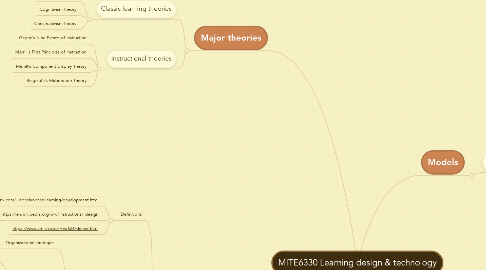
1. Concepts
1.1. Instructional Design
1.1.1. Definitions
1.1.1.1. http://www.nwlink.com/~donclark/hrd/learning/development.html
1.1.1.2. https://en.wikipedia.org/wiki/Instructional_design
1.1.1.3. https://www.umich.edu/~ed626/define.html
1.1.2. Strategies of Instructional Design
1.1.2.1. Organizational strategies
1.1.2.1.1. lesson should be properly arranged and sequenced
1.1.2.2. Delivery strategies
1.1.2.2.1. Social Learning and Social Media
1.1.2.2.2. E-Learning
1.1.2.2.3. M-Learning
1.1.2.2.4. Lecture
1.1.2.2.5. Video
1.1.2.2.6. Classrooms
1.1.2.3. Management strategies
1.1.2.3.1. Action leanring
1.1.2.3.2. Boot Camp
1.1.2.3.3. Fishbowls
1.1.2.3.4. Lockstep
1.1.2.3.5. Personalized System of Instruction
1.1.2.3.6. Programmed Learning
1.2. Gamification
1.2.1. Apply game elements to non-game contexts
1.2.1.1. Game elements: points, levels, badges, leaderboards, etc.
1.2.1.2. Wide applications: healthcare, government, transportation, and education (Robson et al., 2015).
1.2.1.3. Motivate human behavior in two connected ways: reinforcements and emotions (Robson et al., 2015)
1.2.1.4. The effectiveness of gamification is not stable (Hamari et al., 2014; Seaborn & Fels, 2015)
2. Major theories
2.1. Classic learning theories
2.1.1. Behaviorism theory
2.1.2. Cognitivism theory
2.1.3. Constructivism theory
2.2. Instructional theories
2.2.1. Gagné’s Nine Events of Instruction
2.2.2. Merrill's First Principles of Instruction
2.2.3. Merrill's Component Display Theory
2.2.4. Reigeluth's Elaboration Theory
3. Models
3.1. The ADDIE model
3.1.1. History of ADDIE model
3.1.1.1. http://www.nwlink.com/~donclark/history_isd/ADDIE_timeline.png
3.1.1.2. http://elearninginfographics.com/wp-content/uploads/History-of-Instructional-Design.png
3.1.2. Five phases of ADDIE model
3.1.2.1. Analysis
3.1.2.1.1. Needs analysis
3.1.2.1.2. Learner analysis
3.1.2.1.3. Task analysis
3.1.2.2. Design & development
3.1.2.2.1. Key skills
3.1.2.2.2. Design principles
3.1.2.3. Implementation
3.1.2.3.1. Pilot
3.1.2.3.2. Train the trainer
3.1.2.3.3. Roll out
3.1.2.4. Evaluation
3.1.2.4.1. Why evaluate?
3.1.2.4.2. What to evaluate?
3.1.2.4.3. How to evaluate?
4. Processes
4.1. Design video-based learning
4.1.1. Script writing
4.1.2. Storyboarding
4.1.3. Video shooting
4.1.4. Audio
4.1.5. Non-technical
4.1.6. Editing & output
